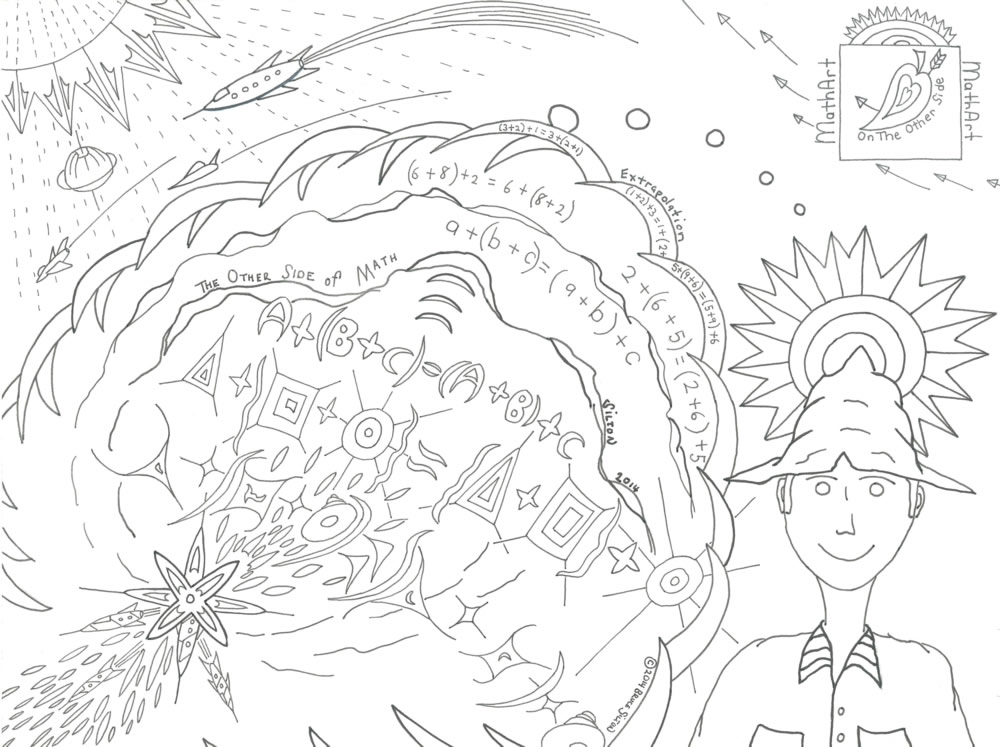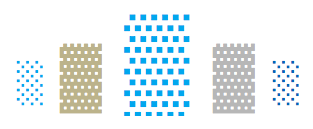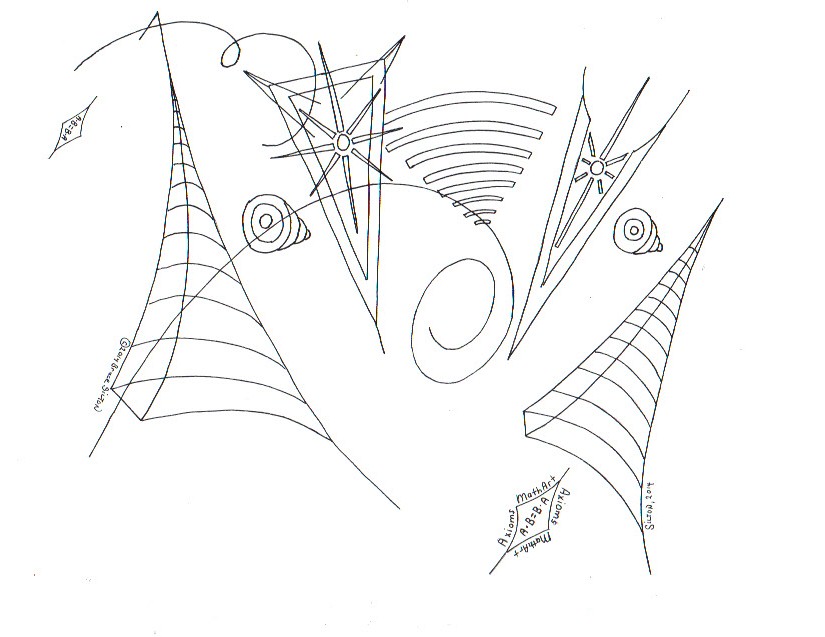The Other Side of Math
∞ PART THREE-B ∞
TWO EXTRAPOLATIONS
ON THE OTHER SIDE OF MATH

The Other Side of Math
 BEYOND PROBLEM CREATION
BEYOND PROBLEM CREATION
 An Abstract Drawing of the Real-Number Axiom a + b = b + a
An Abstract Drawing of the Real-Number Axiom a + b = b + a
Definition of Extrapolation: Extrapolation is the activity of starting from known facts and using them as the basis for drawing conclusions and making general statements about a situation or what is likely to happen in the future. Known facts are the starting point in extrapolation. (1) Conclusions, (2) general statements about a situation, and (3) what is likely to happen in the future are derived from these known facts.
The Theory and Practice of Problem Creation in Mathematics leads directly to two additional ideas. These two ideas are extrapolations. They are the foundation of the six-step OSOM program as a whole.
Both extrapolations are based on this observed datum:
DURING A PERIOD OF ELEVEN YEARS (2007-2017), WHEN I HAVE CORRECTLY APPLIED PROBLEM CREATION, PROBLEM SOLVING AND CHECKING ANSWERS TO MATH STUDENTS HAVING SERIOUS DIFFICULTY LEARNING THEIR MATH LESSONS, I HAVE GOTTEN UNIFORMLY GOOD RESULTS.
From this remarkable fact, I have formulated two general statements about how to educate students in mathematics with the intention of producing a person who can create with math to the utmost of his potential.
When combined with Problem Creation, the following two extrapolations predict and potentially solve a previously unsolvable problem in the field of math education — how to provide very large numbers of students (millions — and perhaps billions!) with a complete and creative education in mathematics.
These two extrapolations are not facts. But they are reasonable predictions based on the knowledge I have gained through giving 17,000 plus tutoring sessions in all academic subjects to students in kindergarten through 12th grade.
………………………………
To restate the first prerequisite: In order to begin Step 2, Problem Creation, the student must demonstrate complete mastery of the current math topic being studied. Not only that, he must demonstrate mastery using the rules, definitions and solutions delineated in his textbook. OSOM builds upon the mastery of the textbook’s lessons; it is not a substitute for the textbook’s lessons.
Mastery of the student’s textbook lesson is Step 1. Problem Creation is Step 2.
PLEASE, DO NOT SKIP STEPS!
 FIRST EXTRAPOLATION
FIRST EXTRAPOLATION
THE SYSTEMATIC AND CONSISTENT APPLICATION OF PROBLEM CREATION BY AN INDIVIDUAL STUDENT, FROM FIRST THROUGH TWELFTH GRADES, TO EVERY MAJOR MATH TOPIC IMMEDIATELY AFTER EACH TOPIC IS MASTERED BY THAT STUDENT, AS AN INTEGRAL PART OF A CAREFULLY STRUCTURED, WELL-TAUGHT MATH CURRICULUM, WILL PRODUCE A GREATLY ENHANCED ABILITY BY THAT STUDENT TO APPLY MATH TO REAL-LIFE, AS WELL AS INCREASED CREATIVENESS IN AND WITH MATHEMATICS.

 REMEDY FOR THE MATHEMATICAL BOX
REMEDY FOR THE MATHEMATICAL BOX
Consider the sheer quantity of self-created certainties that a student could accumulate in his twelve years of schooling from first through twelfth grades:
- In our Lower School (first through third grades) we use Macmillan mathematics texts that are structured into approximately 10 units per year. Each unit contains a minimum of 10 to 15 distinct major skills and many more minor skills. For example, Unit Three of Third Grade Math contains the following 13 distinct, major skills: adding 2-digit numbers; regrouping ones, regrouping tens, regrouping tens and ones, using tables, mental arithmetic, three addends, even and odd numbers, regrouping hundreds, adding 4-digit numbers, adding money, estimating sums and sensible answers.This same unit also contains a number of valuable but less important (minor) skills.
- In our Middle and Upper Schools (4th through 12th grades), we use Saxon textbooks. Each Saxon textbook is divided into approximately 130-140 lessons. Some lessons teach only one major topic, but many teach two or three separate major skills. These same lessons contain many additional, minor skills that can be used in real-life situations.
If a student completes his math courses at the expected rate of one textbook per year from first through twelfth grades, he will have the accumulated, self-determined certainty gained from mastering and then creating, solving and checking problems with approximately 1250-1750 major topics, each one of which represents a distinct ability gained by the individual. This predicts a vastly superior result for an OSOM student compared to a student who has merely completed his textbooks and their related exams using only what is contained in the books themselves.
In actual fact, there are (very conservative estimate) 1000, 2000 or more additional minor skills that are learned in the process of mastering the above major topics. When I have adequate time, I normally apply Problem Creation to many of these minor skills. The process goes very, very quickly, a few minutes at most if the student has mastered them.
But even that enhanced product comes from merely applying Step 2.
The gains from Problem Creation should be magnified greatly by the added potential gains in knowledge and skill coming from the rest of the program, OSOM Steps 3, 4, 5 and 6, as predicted by my Second Extrapolation.
 SECOND EXTRAPOLATION
SECOND EXTRAPOLATION

OPERATING IN INTIMATE CONJUNCTION WITH (1) THE PRACTICE OF PROBLEM CREATION IN MATHEMATICS AND (2) THE FIRST EXTRAPOLATION STATED ABOVE, AND STARTING AS EARLY AS THE 4th or 5th GRADE IN A CHILD’S EDUCATION WITH THE USE OF STEPS 3, 4, 5, AND 6 OF OSOM: THE COMPLETE OSOM PROGRAM WILL PRODUCE A GREATLY ENHANCED ABILITY BY THE INDIVIDUAL TO APPLY MATH TO REAL-LIFE, INCREASED CREATIVENESS IN AND WITH MATHEMATICS, PLUS MORE ENGINEERS, SCIENTISTS AND GREAT MATHEMATICIANS THAN WAS PREVIOUSLY POSSIBLE.
 OSOM STEPS 3, 4, 5, AND 6
OSOM STEPS 3, 4, 5, AND 6
► OSOM STEP 3: ALTERNATIVES
Step 3, Alternatives, elevates elementary and secondary school students to a level of competence and confidence in knowing and using alternatives — alternative statements of axioms and theorems, alternative algorithms for common operations, alternative numerations systems, alternative definitions of terms, alternative solutions to problems, alternative methods of checking answers.
The result? Students who know and use alternatives to the math in their textbook soon realize that their textbook is just ONE of many sources of valid math ideas and practices. When Step 3 is presented and taught at the correct level of simplicity, some (or many) of those students will realize that they, too, can contribute their own ideas to the subject. When this occurs, the doors to creative thought have opened.
FOLLOWED BY
► OSOM STEP 4: INSPIRING EXAMPLES: The History of Mathematics; Mankind’s Math and Science Greats
Step 4, Inspiring Examples, is an in-depth, structured study and research to learn about the history of mathematics, the development of specific vital subjects and topics in mathematics (for instance, algebra, geometry, irrational numbers, the number zero, the negative numbers. etc.) and the lives of humanity’s math and science greats.
Competent and successful professionals often know the complete history of their subject — and that, of course, includes the people who originated and developed it. They understand how and why that historical subject became the current version. They have a firm grip on the breakthrough ideas and technologies of the past and how these relate to their current activity. Because of this knowledge, they can skillfully advance with or ahead of their subject as it evolves into the future, using data about the past to help mold the future they want to create.
The time track of mathematics stretches back some 8000 years into Earth’s past. It is particularly rich with data, concepts and solutions that can be evaluated, compared to and sometimes used in the present. For this reason, both students and math professionals often study math’s history along with the lives and works of mankind’s’ math and science greats.
But what if a student knows only the math of the present and recent past? Without a grasp of historical knowledge, a student can easily be locked into the mathematical box of his school, book and teachers, unable to even conceive that he, an individual, can create on his own with the subject.
REMEMBER THIS DATUM: EACH MATHEMATICAL IDEA AND EACH SKILL HAS A PAST. KNOWING THAT PAST YIELDS HIGHER LEVELS OF UNDERSTANDING, CONTROL, AND MASTERY OVER THE PRESENT AND THE FUTURE.
When the examples and history of Step 4 are presented in an easily understandable form, some (or many) of the students will be inspired to create and contribute to our fund of useful mathematical knowledge and skills — and they will have stepped outside the mathematical box.
FOLLOWED BY
► OSOM STEP 5: IDENTIFYING THE TARGET: Mankind’s Past, Present and Future Technologies – the Good, the Bad and the Ugly:
Step 5, Identifying the Target, is a detailed, structured survey of the math and math-based sciences used in past technologies, present technologies and in (planned-for) future technologies, with the intent to identify the good technologies (constructive), the bad technologies (destructive) and the ugly technologies (intentionally destructive.) Step 5 is intended to develop a math student (and, later, a math and science professional) who possesses a strong, well-defined moral code and sufficient personal integrity so that he can apply math for the greatest good and whose judgment will not be governed solely by short-term, personal gain.
FOLLOWED BY
►OSOM STEP 6: EXTRAPOLATION, DISCOVERY AND INVENTION— Good Ideas, Better Ideas and Big Ideas
According to my Second Extrapolation, students learning math on the full OSOM program (Steps 1 through 6) will – at some point in their program — begin extrapolating, discovering and inventing along mathematical lines. They will carry out these creative activities because it is natural for them to do so once they are encouraged to create problems, learn alternatives, understand the history of math and mathematicians, and identify mankind’s good, bad, and ugly technologies that depend upon math for their effectiveness.
In my opinion (not a fact), students will begin extrapolating, discovering and inventing along mathematical lines literally years before they finally “reach” Step 6. But once all the earlier OSOM steps are done, it is on Step 6 that OSOM intentionally and directly works at the highest level the individual is capable of: extrapolation, discovery and invention in and with mathematics.
THIS SIX-STEP OSOM PROGRAM IS INTENDED TO REMEDY “THE MATHEMATICAL BOX” – OUR CURRENT “ONE MATH ONLY” SITUATION.
 IMPLEMENTING OSOM
IMPLEMENTING OSOM
Using only the detailed descriptions, directions, and advice in this book, Step 2 of OSOM can easily be used with students.
However, for OSOM Steps 3, 4, 5 and 6 to be implemented properly and thoroughly, a new series of short, structured courses must be designed, developed and produced that guide students through these steps at a level of language and image that can be rapidly understood by elementary, middle, and high school students.
The materials for these new courses must be simply written, thoroughly illustrated, accompanied by comprehensive glossaries, and should utilize the best of our current audio-visual technologies for producing complete assimilation of ideas: cartoons, You Tube videos, short films, etc. – including practical exercises that require the student to apply these ideas to real-life situations. (Naturally, the curriculum materials designed for 4th, 5th, and 6th graders will not be the same as the materials developed for high school students.)
 WILL THE ENTIRE OSOM PROGRAM WORK?
WILL THE ENTIRE OSOM PROGRAM WORK?
Definition of “pilot”: In business and industry, a “pilot” is a carefully planned test of a new product, service or system to discover and solve problems before full implementation of that product, service or system.
Will the 6 steps of the OSOM program work exactly as stated in this paper to help us produce more powerful math kids and more creative mathematicians and scientists? Possible, but very unlikely, as it has never been done before on a systematic basis. The entire OSOM program will require considerable “piloting” to uncover any “bugs” and work them out.
Parts 9A, 9B and 9C of the complete book lay out pilot programs to help curriculum developers and other educational professionals get started.
PILOT PROGRAMS ARE THE ANSWER.
 A WORD OF CAUTION
A WORD OF CAUTION
When considering changes to OSOM during pilot programs, please keep in mind this aspect of my first principle: ANY AND ALL ALTERATIONS MADE TO OSOM SHOULD BE CALCULATED ONLY TO INCREASE THE STUDENT’S SELF-CONFIDENCE, INDEPENDENT INITIATIVE, IMAGINATION AND CREATIVENESS IN AND WITH MATH, NOT TO DILUTE OR NEGATE THIS PURPOSE.

TEACHERS, NOTE CAREFULLY
- There are known causes for student difficulty in studying and learning the mathematics contained in the student’s textbook.
- There are also known and effective remedies for handling these study difficulties.
- But student study difficulties and their effective remedies are not the subject of OSOM. This paper on the “Other Side of Math” deals mainly with curriculum: how to provide students with a COMPLETE education in math, one that includes and emphasizes the creative side of the subject.

